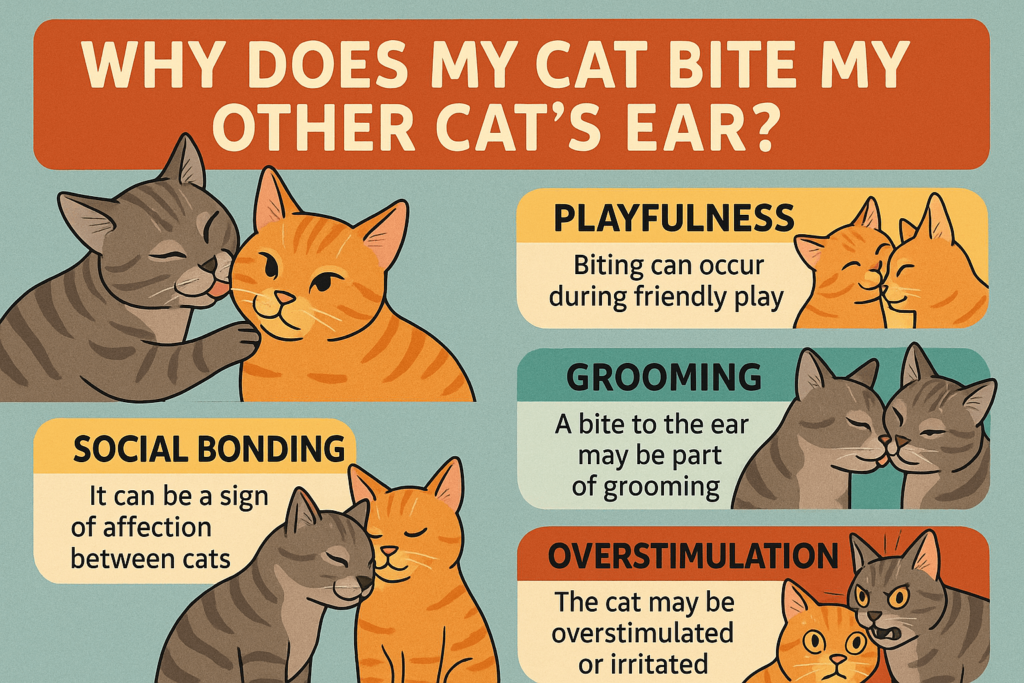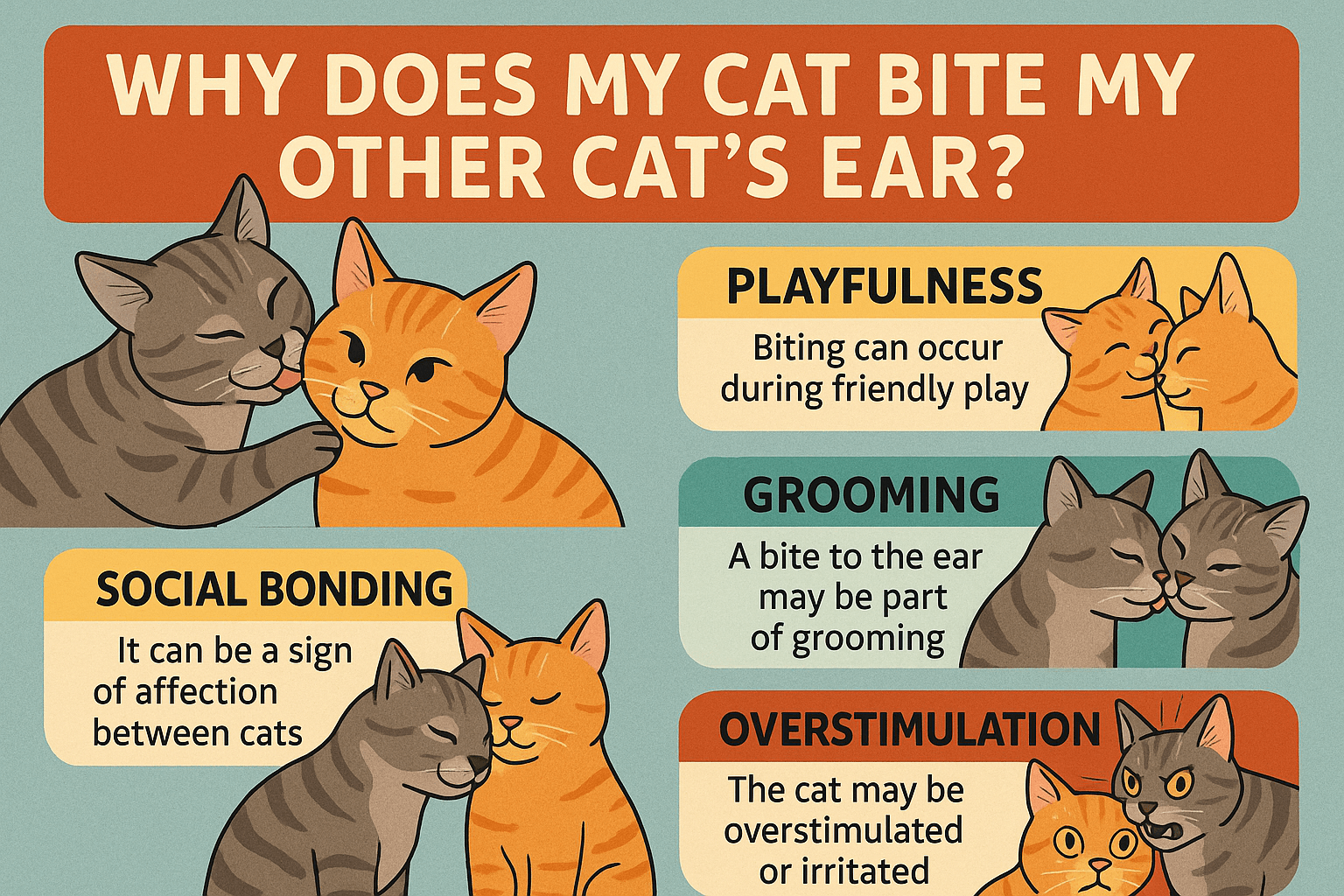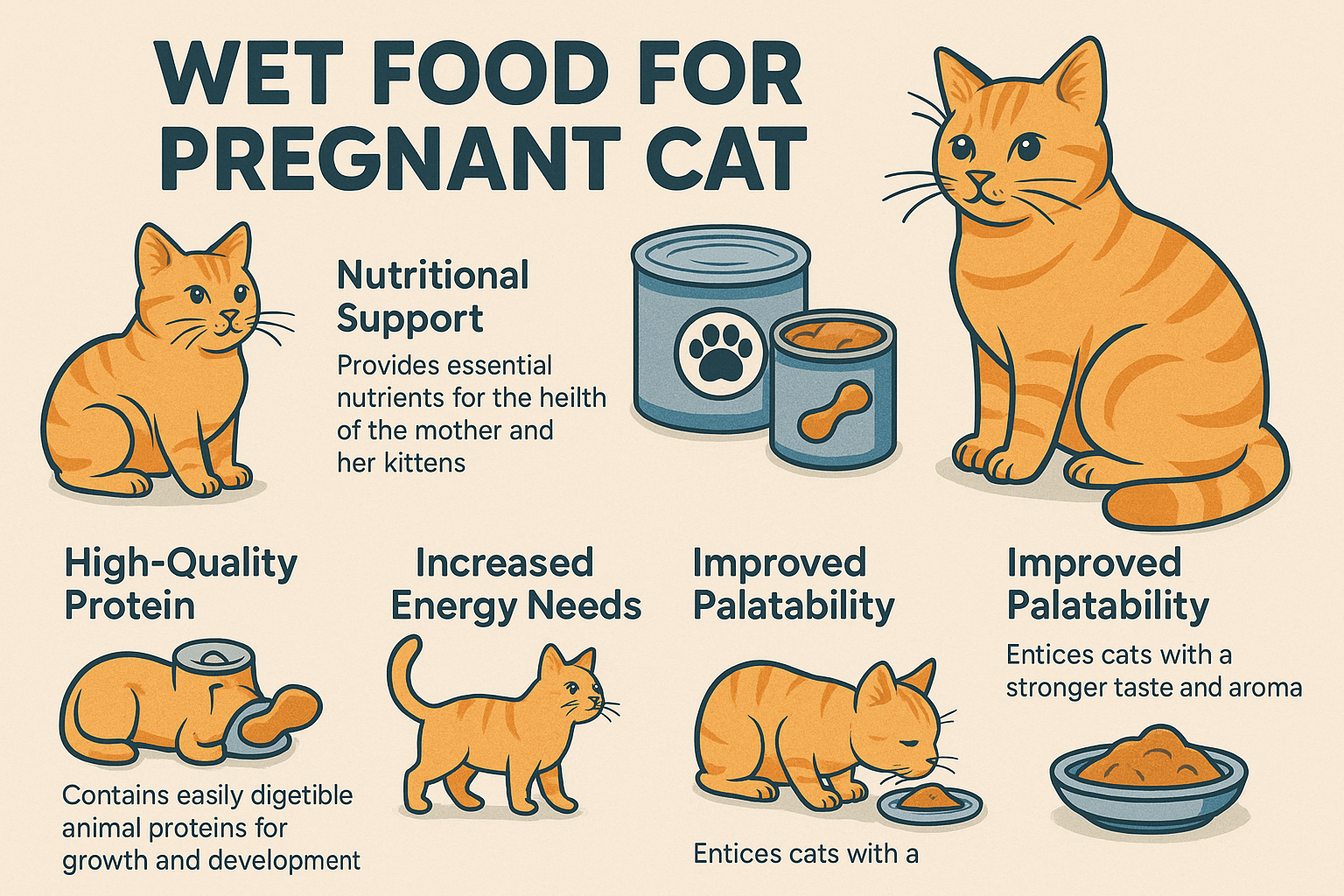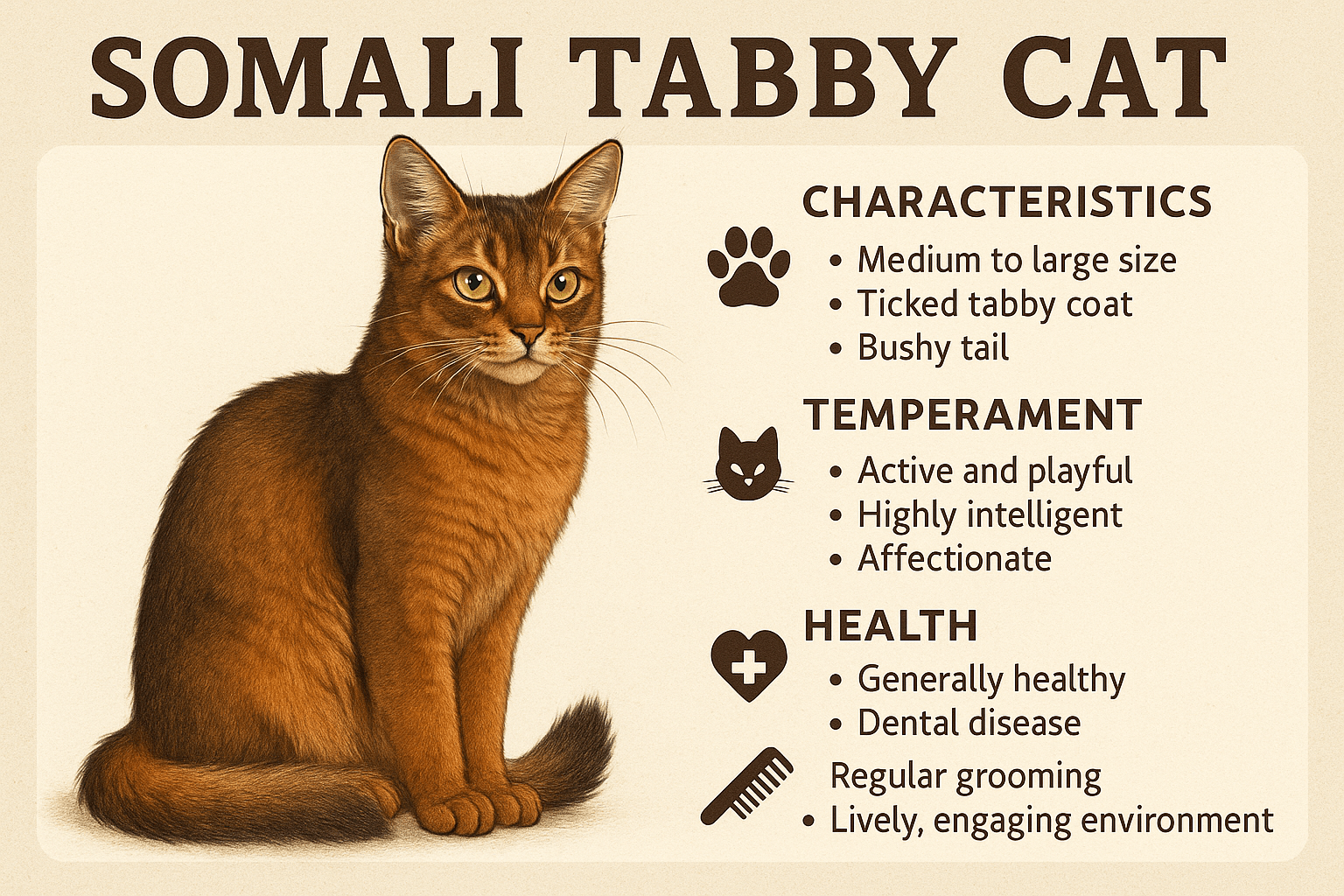Why Does My Cat Bite My Other Cats Ear?
If you’ve ever caught your cat nibbling on another feline’s ear, you might be wondering what’s behind this quirky behavior. While it can seem strange or even concerning at first glance, there are several reasons why cats engage in this type of interaction. From playful antics to establishing dominance, ear biting is often a natural part of feline communication and social dynamics. In this blog post, we’ll explore the possible explanations for this behavior, how to interpret it, and what steps you can take to ensure your cats remain happy and harmonious housemates. Let’s dive into the fascinating world of feline relationships!
Common Reasons Why Cats Bite Each Other’s Ears
Ear biting between cats can stem from a variety of motivations, depending on their personalities, environment, and relationship. Understanding these reasons helps decipher whether the behavior is harmless or requires intervention.
Playful Behavior:
Cats often use gentle nibbling as part of playtime. Biting ears can be a way to initiate fun interactions or simulate hunting behaviors.Grooming Instincts:
Cats are natural groomers, and sometimes they extend this care to their companions. Ear nibbling may mimic grooming, especially if one cat is trying to clean the other.Affectionate Bonding:
Gentle ear biting can be a sign of affection or trust between cats. It’s their way of showing closeness and strengthening their bond.Establishing Dominance:
In multi-cat households, ear biting might serve as a subtle way for one cat to assert dominance over another. This is usually paired with other body language cues.Redirected Aggression:
If a cat feels frustrated or threatened by something outside their control (like seeing another animal through the window), they might redirect that energy onto their housemate’s ear.
By observing your cats’ overall demeanor and context, you can better understand whether ear biting is a harmless habit or a sign of underlying tension.

Signs That Ear Biting Is Harmless vs. Problematic
Not all instances of ear biting are created equal—some are perfectly normal, while others could indicate stress or conflict. Here’s how to tell the difference.
Body Language During Interaction:
Relaxed body posture, purring, or slow blinking suggests playful or affectionate intentions. Hissing, growling, or puffed-up fur indicates aggression.Frequency of the Behavior:
Occasional ear nibbling during play or grooming is normal. Frequent or intense biting may signal an issue that needs addressing.Reaction of the Other Cat:
If the recipient seems comfortable and doesn’t try to escape, the behavior is likely harmless. A defensive response, like swatting or running away, points to discomfort.Presence of Physical Harm:
Check for signs of injury, such as redness, scabs, or bald patches around the ears. Persistent wounds require immediate attention.Changes in Overall Dynamics:
Sudden shifts in behavior, such as increased fighting or avoidance, suggest unresolved tension between your cats.
Understanding these distinctions ensures you can intervene appropriately when needed.
Check this guide 👉Why Does My Cat Bite My Ankles? Best 7 Expert Tips!
Check this guide 👉Why Does My Cat Bite Me While Purring? Best 7 Behavior Tips!
Check this guide 👉Why Does My Cat Bite Me Gently Out of Nowhere? Best 7 Tips!
Harmless Ear Biting Signs | Problematic Ear Biting Signs |
|---|---|
Playful body language | Hissing or growling |
Occasional nibbling during grooming | Frequent or aggressive biting |
Recipient remains calm and relaxed | Recipient tries to escape or retaliates |
No visible injuries or irritation | Redness, scabs, or bald spots near ears |
Consistent friendly interactions | Increased tension or fighting |
How to Address Problematic Ear Biting
If ear biting has become excessive or harmful, there are steps you can take to restore harmony in your multi-cat household. These strategies focus on reducing stress and fostering positive interactions.
Provide Separate Spaces:
Ensure each cat has their own safe space with food, water, litter boxes, and cozy hiding spots to reduce competition and territorial disputes.Increase Environmental Enrichment:
Offer toys, scratching posts, and climbing structures to keep your cats entertained and prevent boredom-related conflicts.Introduce Scheduled Playtime:
Regular interactive play sessions help burn off excess energy and redirect aggressive tendencies toward appropriate outlets.Use Positive Reinforcement:
Reward calm and friendly interactions with treats or praise to encourage good behavior between your cats.Consult a Veterinarian or Behaviorist:
If the problem persists, seek professional advice to rule out medical issues or receive tailored guidance for resolving conflicts.
Taking proactive steps can help resolve problematic behaviors and create a peaceful coexistence among your feline companions.
Tips for Strengthening Bonds Between Your Cats
Building strong, positive relationships between your cats can minimize conflicts and foster a harmonious home environment. Try these tips to nurture their bond.
Gradual Introductions for New Cats:
If introducing a new cat, start with scent swapping and supervised meetings to allow them to get used to each other gradually.Encourage Shared Experiences:
Feed your cats simultaneously but at a distance to associate mealtime with positive feelings. Over time, decrease the space between them.Create Neutral Zones:
Designate areas where neither cat claims territory, allowing them to interact without feeling defensive.Use Calming Products:
Pheromone diffusers or sprays can help reduce anxiety and promote relaxation in multi-cat households.Monitor Stress Triggers:
Identify potential stressors, such as loud noises or changes in routine, and address them to maintain a calm atmosphere.
Strengthening your cats’ bond takes patience, but the effort pays off in a happier, more peaceful household.
How to Distinguish Playful vs. Aggressive Behavior
Cats communicate through a mix of physical gestures and vocalizations, making it essential to distinguish playful behavior from aggression. Here’s how to decode their actions.
Playful Posture:
Cats engaging in play often crouch low, wiggle their hindquarters, and pounce lightly. Their movements are fluid and energetic.Aggressive Stance:
Aggressive cats arch their backs, puff up their tails, and flatten their ears. They may also hiss or growl loudly.Vocal Cues:
Chirps, trills, and soft meows typically accompany playful behavior. Loud yowls or screams indicate frustration or anger.Claw Usage:
Playful cats sheathe their claws most of the time, while aggressive ones unsheathe them fully during attacks.Duration of Interaction:
Play sessions are short-lived and end naturally. Prolonged or escalating encounters suggest aggression rather than play.
Recognizing these differences helps you intervene only when necessary, preserving the balance of your cats’ dynamic.
Preventing Resource Guarding in Multi-Cat Homes
Resource guarding occurs when one cat feels the need to protect food, toys, or territory from others. Addressing this issue prevents conflicts, including ear biting.
Provide Ample Resources:
Ensure there are enough food bowls, water dishes, litter boxes, and resting spots for each cat. A general rule is one per cat plus one extra.Feed Cats Separately:
Feeding cats in separate areas reduces competition and minimizes anxiety during meals.Rotate Toys and Activities:
Regularly switch out toys to prevent possessiveness and keep playtime exciting for everyone.Supervise Shared Spaces:
Monitor interactions in high-traffic areas to catch early signs of tension before they escalate.Reward Sharing Behavior:
Use treats or praise to reinforce moments when your cats share resources peacefully.
Preventing resource guarding promotes a cooperative and stress-free environment for your feline family.
Managing Stress in Multi-Cat Households
Stress can exacerbate conflicts and lead to behaviors like ear biting. Managing stress effectively keeps your cats content and reduces tensions.
Maintain a Routine:
Cats thrive on predictability. Stick to consistent feeding, play, and bedtime schedules to provide stability.Limit Loud Noises:
Minimize sudden loud sounds, such as vacuum cleaners or doorbells, which can startle cats and trigger stress responses.Offer Vertical Space:
Install shelves or cat trees to give your cats elevated perches where they can retreat and observe their surroundings safely.Introduce New Changes Gradually:
Whether it’s a new pet, furniture, or routine, introduce changes slowly to allow your cats time to adjust.Spend Quality Time Together:
Engage in one-on-one bonding sessions with each cat to make them feel loved and secure within the household.
Managing stress ensures a harmonious living space where your cats can coexist peacefully.
Frequently Asked Questions About Cats Biting Ears
Is ear biting always a bad sign?
No, ear biting is often playful or affectionate. However, watch for signs of distress or injury to determine if it’s problematic.
What should I do if my cats fight after ear biting?
Separate them immediately and reintroduce them slowly once they’ve calmed down. Consider consulting a behaviorist if fights continue.
Can jealousy cause ear biting?
Yes, jealousy over attention or resources can lead to biting. Ensure each cat feels equally valued and provided for.
Should I punish my cat for biting?
Punishment can escalate tension. Instead, redirect their behavior with toys or treats and reinforce positive actions.
When should I see a vet about ear biting?
Consult a vet if there are signs of injury, persistent aggression, or sudden changes in behavior that could indicate health issues.
Creating a Peaceful Multi-Cat Household
Understanding why your cat bites another’s ear—and knowing how to respond—is key to maintaining a balanced and loving environment for your pets. Whether it’s playful antics, grooming instincts, or occasional spats, most behaviors are manageable with patience and observation. By providing plenty of resources, enrichment, and support, you can help your cats build strong, healthy relationships. Remember, every feline pair is unique, so tailor your approach to their individual needs. With time and care, your cats will thrive together, bringing joy and companionship to your home.
Aspiration Pneumonia in Cats: Best 7 Expert Tips! Discover causes, symptoms, and treatment advice to protect your cat’s respiratory health and ensure a speedy recovery.
Wet Food for Pregnant Cats: Best 7 Expert Tips! Discover essential advice on feeding wet food to pregnant cats, ensuring proper nutrition for mom and kittens. Learn what to look for and how to care!
Why Does My Cat Bite My Other Cats Ear? Best 7 Expert Tips! Discover reasons behind this behavior, how to interpret it, and expert advice to ensure harmony in your multi-cat household.
Somali Tabby Cat: Best 7 Expert Tips! Discover expert advice on caring for a Somali tabby cat, from grooming and health to personality and fun facts. Perfect for cat lovers!




